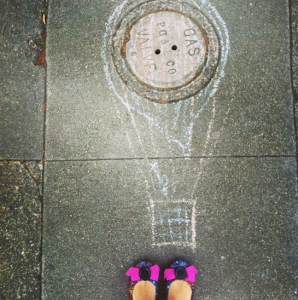Social Capital and Middle America
 Alicia here. Commuting into work is still an adjustment. Back on the road, every day was a commute, but it was a commute with fresh scenery and wonderment as to whether we’d find a good cup of coffee (for me) and pot of tea (for Megs). Now unless I take time to notice, the scenery is the same.
Alicia here. Commuting into work is still an adjustment. Back on the road, every day was a commute, but it was a commute with fresh scenery and wonderment as to whether we’d find a good cup of coffee (for me) and pot of tea (for Megs). Now unless I take time to notice, the scenery is the same.
This has to do with the fifty first dates trip (eventually). Promise.
This morning while sitting in a casual carpool ride, I watched spinning wheels carrying just a single person whir by me, one after another. I looked around my carpool and thought about the tacit rules that run the system: no talking unless the driver talks, no food, no comment on the music/talk radio station. With these moments together, a thought came over me: is it not peculiar that though we’re a social society, we often crave being alone in a crowd? We don’t so much want to be alone as we want to know there are other people near us but not interacting with us. Socially interlackin?
Research has been done on this very subject. Interesting to note, the most famous book tackling the trend of wanting to do things solo, Bowling Alone, was published pre social networking, and thus makes me wonder just how much the Friendster/MySpace/Facebook/
All this information reminded me of Meg’s and my experiences through highways, small towns, truck stops and bigger cities across America. Our adventures led to the kindness of strangers, which led Megan to the concept of American’s Are the Heroes. And I couldn’t help but wonder why there seemed to be so much more kindness and willingness to help in middle America than there is in California.
Well, social capital of course.
Think about it. Populations of rural areas and smaller cities rely on one another for what they need. Their relationships aren’t merely for pleasure, but because they need one another. There’s not an institution where several doctors are housed: there is one town doc. There’s one butcher who cuts and sells your meat, not a plethora of choices so if you dislike one guy you can go somewhere else. Add to it that there’s less of a need to pick up the phone because walking to your neighbor’s house is just as easy and hey, why not walk to get a cup of coffee since you know everyone in town anyway?* Throw a stranger into the mix and the town, like a vaccine, protects them with the same social capital they surround each other with.
Big cities are bursting with social capital too. Urban renewalist Jane Jacobs fought tooth and nail to demonstrate that urban neighborhoods are valuable and worth preserving for precisely this reason. Give someone a community, and you’re giving someone a reason to live it seems.
As much as there are flaws in social media and with social media – I’m seeing it’s bright side more and more. 50/50 wouldn’t exist without the social capital derived from social networking. And I am already envisioning a world where the virtual social networks start actually becoming reality based ones; it’s just going to take effort on the parts of those who believe in networks (ie: making it work even when it’s inconvenient) and persistence in spite of setbacks.
I might be too idealistic. But I think middle America has it right.

 Follow
Follow